Chinese New Year: Eye of the Tigerfeatured
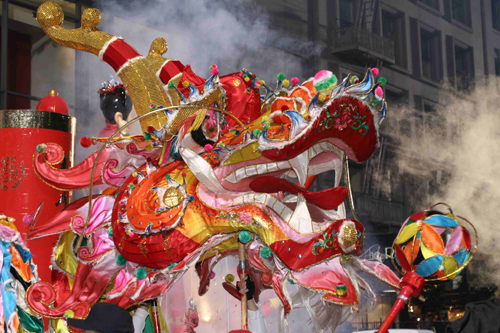
Photo Credit: Knight Lights Photography
February 14, 2010. Doily valentines, conversation hearts, and sugar-coated smooches, step aside. This year, you’ll have to share the spotlight with the Tiger. Rawrrr. {Cue firecrackers and those darned little Pop Pops the kids are still playing with.}
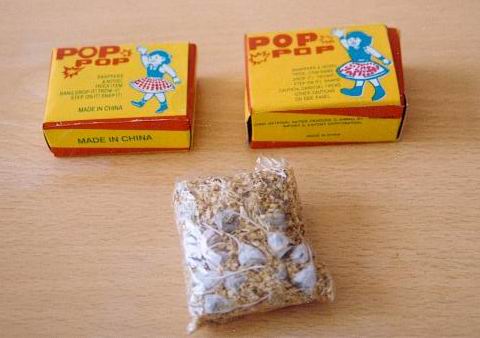
Pop Pop Pop
It’s the Year of the Tiger and on February 14th, the first day of the first lunar month in the Chinese calendar this year, the Tiger’s reign will begin. On New Year’s Eve, Asian families all over the world will be celebrating with a dinner feast.
As is customary in Chinese celebrations, food is of the utmost importance and various dishes have symbolic meanings.
Last year, to welcome in the Year of the Ox, we had a true Lucky Feast. I’m still noodling on what will be on the menu this year, but certain traditional items are must-haves.
1. Dumplings (Jiao Zi) = prosperity
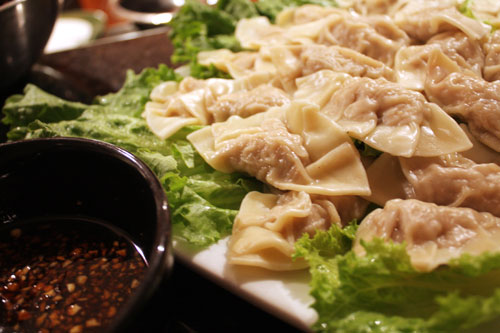
Pork and Shrimp Dumplings
The Chinese are really into prosperity and good luck, so anything that can help bring those thing along in the new year are important. For example, the color red (this is why red foods like lobster are often served at New Year celebrations and wedding banquets). For another example, and a tad more affordable, dumplings (jiao zi in Chinese). Making homemade dumplings can be a fun group activity, and the pay off is delicious. For some great tips on dumpling-making, I turn to the dumpling queen herself, Andrea Nguyen. Author of Asian Dumplings, Andrea knows a thing or two about these prosperity-bearing pouches of goodness.
2. Noodles = a long life
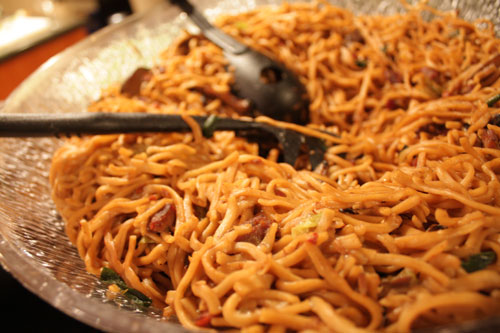
Lo Mein
Lo mein is a classic, and is a great filler if you have a lot of guests. I’m partial to the way my mom makes it, with thicker-cut Shanghai-style noodles and generous amounts of marinated mushrooms, barbecue pork, scallion, Napa cabbage, egg, and goji berries.
3. White Cut Chicken with Ginger-Scallion Oil = happiness & purity, and family as well if it’s served whole
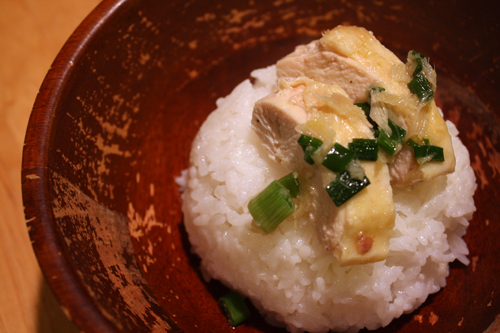
White Cut Chicken (bok cheet gai) with Ginger-Scallion Oil
A simple recipe with vibrant flavors, White Cut Chicken (or as it’s called in Chinese, bok cheet gai) with Ginger-Scallion Oil is so good you’ll be making this well into the new year. The white chicken symbolizes “happiness and purity,” and if it is presented whole (yes, with the head and the butt on the plate), it also signifies “family.” I’ll abstain from chicken butt jokes now.
4. Steamed Whole Fish = an abundance of good luck
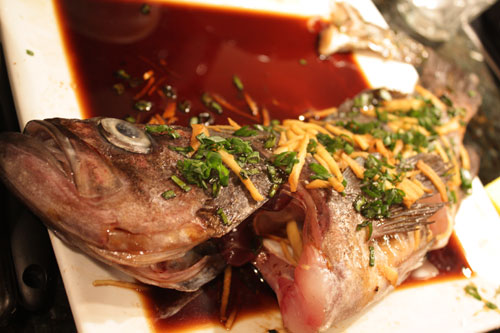
Steamed Whole Fish with Ginger and Scallion
Much less intimidating than it looks, the fresh fish is simply prepared with soy sauce, ginger, and scallion. Similar to how the chicken is finished off, the fish is topped with a mixture of hot vegetable oil poured over fresh scallions. The fish is served whole, with the head and tail intact to ensure a good start and finish in the New Year.
5. Black Moss Seaweed = good fortune
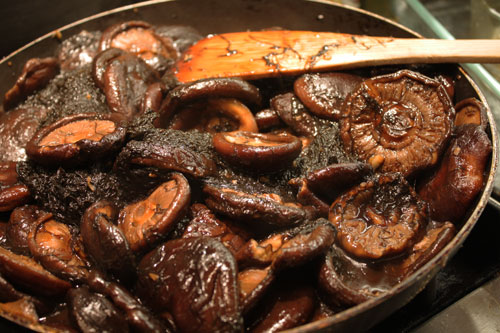
Mushrooms and Black Moss Seaweed (Dong Gu Fat Choy)
Black Moss Seaweed is called fat choy in Chinese. Literally translated, it means “hair vegetable.” Makes sense, huh? It looks uncannily, and unappetizingly, similar to masses of black hair. Fat choy is also a homophone in Chinese for “good fortune.” It is served with braised Chinese mushrooms in a mixture of oyster sauce, soy sauce, and sugar for a full, savory flavor…and is slightly less scary looking that way.
6. Tray of Togetherness (sweets = good luck)
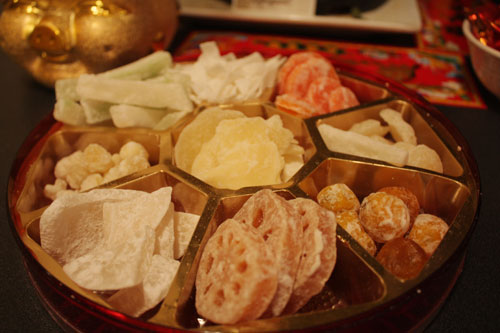
Tray of Togetherness
It is customary to start the New Year with something sweet. This tray is full of eight (a traditional lucky number) different treats like candied dried fruits and coconut.
7. Kumquats = prosperity
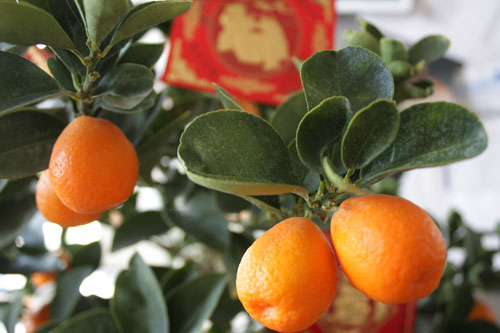
Lucky golden kumquat tree
Translated, kumquat means “gold orange” and during Chinese New Year, families and businesses often showcase the whole kumquat tree, or the fruit with stems and leaves attached (which symbolizes strong relationships). Eat them whole, skin and all. The peel is usually pleasantly sweet, although the flesh can be mouth-puckeringly tart. I solved this problem last year by making Kumquat Vanilla Marmalade from my happy little kumquat tree.
8. Orange Slice Jello Shots = a good time
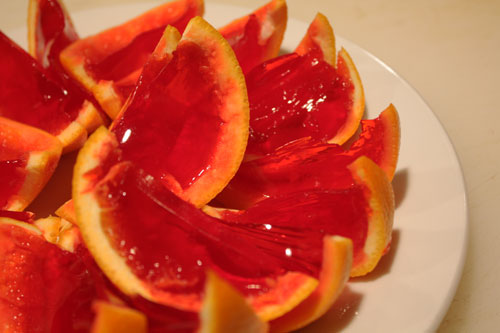
Orange Slice Jello Shots
Not a “traditional” dish per se, but could very well be the makings of a new classic! Needless to say, these were a hit at last year’s Chinese New Year party. I saw this brilliant idea on Adventures in Amateur Baking and Cooking. Oranges symbolize wealth, so make your boozy jello with some orange-flavored vodka and just wait for double the riches to come pouring through the door.
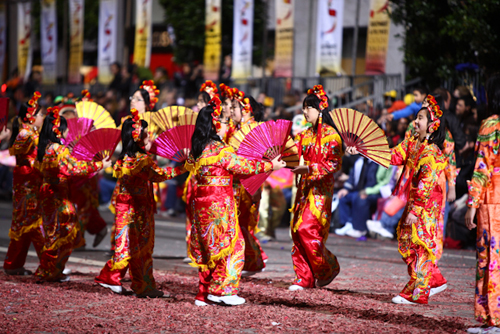
Photo Credit: Knight Lights Photography
Finally, don’t forget about the Chinese New Year Parade, a San Francisco tradition since the 1860’s. This world-famous parade will include a 250-foot long Golden Dragon, lion dancers, stilt walkers, acrobats, and elaborate floats.
Chinese New Year Parade, San Francisco
Saturday, February 27, 2010
5:15 pm – 8:00 pm
Location: Market and Second Street to Kearny and Jackson
Parade Route


 Print Recipe
Print Recipe



Add comment